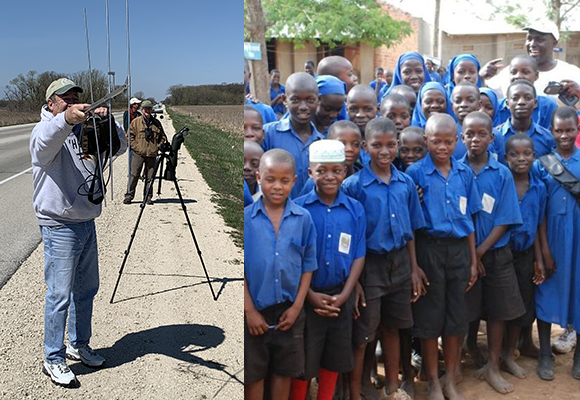
Dear Friends,
I took a break from my home office last week to get outside and look for Whooping Cranes and other waterbirds at Horicon Marsh in Wisconsin. I was scanning the beautiful marsh with my spotting scope when a car pulled up along the road. Out popped our Doug Pellerin, sporting an International Crane Foundation baseball cap and “Whoop It Up” sweatshirt, and armed with a radio tracking antenna.
“There’s a Whooping Crane just to the north there,” Doug said, pointing the antenna and tuning the tracker. “It’s number 75-18, a male we released in 2019.” He held up the radio so I could hear the soft, steady beep, beep, beep—Whooper confirmed! With bursting enthusiasm, Doug told me about the Whooping Cranes he’s been tracking in the area, and where pairs are nesting and foraging. His love for the birds and marsh was palpable.
Day in, day out, Doug volunteers to track the Whooping Cranes we’ve reintroduced to this area over the past six years. Doug’s wife, Mako, sewed about 60 masks for our staff and volunteers to use in the field during the COVID-19 crisis. Doug and Mako care for the cranes, and they care for us.
Doug is one of the hundreds of crane custodians, volunteers who are such a vital part of our mission. From Wisconsin to Florida, volunteers work closely with our tracking team leader Hillary Thompson and interns to help us monitor nesting pairs with their eggs and chicks, check key stopover and wintering areas, and chase down the widely wandering tribes of young Whooping Cranes who are not yet ready to settle down with a mate. Volunteers are on the front line of helping us understand and address any threats to this fragile population.
Crane custodians are invaluable all along the migration route of Whooping Cranes. With fewer than 100 Whooping Cranes in the wild across the eastern U.S., we must care for every individual until this new population becomes sustainable. In Indiana and Alabama, with support from our outreach leader Lizzie Condon and her team, our Whooping Crane Ambassadors are working with local communities to help assure that Whooping Cranes are not accidentally (or intentionally) shot on their stop-over or wintering grounds. It takes a village.
Remarkably, volunteers support our mission even in some of the poorest places on Earth. In Uganda, International Crane Foundation biologist Jimmy Muheebwe has been inspiring and nurturing crane custodians for decades, to secure the breeding grounds of Endangered Grey Crowned Cranes—lands that our custodians depend on for their survival, too.
Crane custodians are essential guardians for our rare and threatened cranes. They provide us with monthly monitoring reports that help us understand the status and threats to the population. Their stewardship helps prevent kids from taking eggs, dogs from harassing birds and chicks, and new development threats from degrading wetlands. They also share uplifting conservation messages in churches, community meetings, and schools. Some of our custodians, together with other community members who have entered into Conservation Agreements aimed at providing livelihood benefits in return for conservation action, help us develop and test meaningful land-use strategies, such as bee-keeping and upland fodder production, that reduce pressures on cranes and wetlands.
Collectively, these efforts really work. Over the past five years, Grey Crowned Cranes in Ugandan wetlands with custodians have a higher breeding success than those without—giving us hope for a species that is otherwise declining across this region.
I am so profoundly grateful to our crane custodians and other volunteers worldwide. I am also deeply humbled by their commitment. Many of our crane custodians in Africa come from extremely poor, neglected communities, with limited access to basic water supply, sanitation, and health care. Since the COVID-19 crisis reached Africa in March, it has created daunting challenges for us to interact with these communities we so value—the last thing we want to do is accidentally bring the virus to such vulnerable areas.
This past week in South Africa, however, we had the opportunity to give back to these communities during the crisis. Acknowledging the deep connection our team has with crane custodians and their communities in the Drakensburg and Highland Grasslands regions where three species of cranes breed, we were provided food relief parcels by HCI Foundation and eMedia for those most vulnerable in the communities where we work, supporting more than 1,000 people facing hunger. Our team leaped at the opportunity to help. Thank you, Tanya, Lara, Thabo, and Bradley, for reminding us that we are all in this together, and together we will come out stronger.

Wishing you good health and peace in the days ahead,
Rich Beilfuss
President and CEO
P.S. Volunteers are vital at our headquarters here in Wisconsin too, helping us take care of our rare and genetically-valuable cranes, restore our prairies, and (someday soon!) leading tours of our beautiful remodeled site. Our supporters are vital too! Please consider becoming a Crane Keeper and help provide for everyday caretaking needs at Crane City, exhibits, and our isolation rearing center.
When you become a Crane Keeper, you are donating to the direct daily care of our irreplaceable cranes, and we can’t thank you enough.
